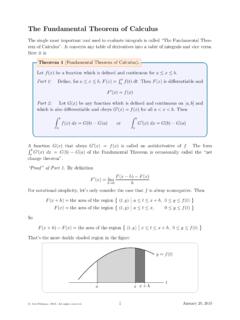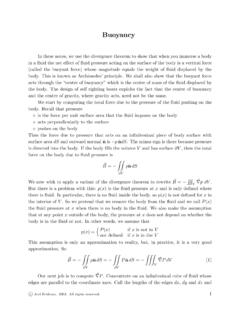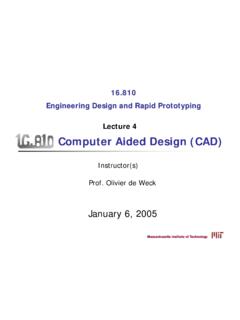Transcription of “THERE IS NO KNOWLEDGE THAT IS NOT POWER.” RALPH …
1 T H E R E I S N O K N O W L E D G E T H AT I S N O T P O W E R .. R A L P H WA L D O E M E R S O N , ( 1 8 0 3 - 1 8 8 2 ). LEAH EDELSTEIN-KESHET. DIFFERENTIAL CALCU- LUS FOR THE LIFE SCI- ENCES. T H E A U T H O R AT T H E U N I V E R S I T Y O F B R I T I S H C O L U M B I A. Copyright 2020 Leah Edelstein-Keshet P U B L I S H E D B Y T H E AU T H O R AT T H E U N I V E R S I T Y O F B R I T I S H C O L U M B I A. ~ License information: Differential Calculus for the Life Sciences by Leah Edelstein-Keshet is licensed under a Creative Commons Attribution-NonCommercial-ShareAlike International License. To view a copy of this license, visit Printing as of January 2020. Contents 1 Power functions as building blocks 25. Power functions 25.
2 How big can a cell be? A model for nutrient balance 27. Sustainability and energy balance on Earth 30. First steps in graph sketching 31. Rate of an enzyme-catalyzed reaction 36. Predator Response 39. A ladybug eating aphids 39. Summary 41. Exercises 43. 2 Average rates of change, average velocity and the secant line 51. Time-dependent data and rates of change 52. The slope of a straight line is a rate of change 54. The slope of a secant line is the average rate of change 55. From average to instantaneous rate of change 58. Introduction to the derivative 61. Summary 63. Exercises 65. 3 Three faces of the derivative: geometric, analytic, and computational 69. The geometric view: zooming into the graph of a function 69. 6. The analytic view: calculating the derivative 75.
3 The computational view: software to the rescue! 80. Summary 82. Exercises 84. 4 Differentiation rules, simple antiderivatives and applications 89. Rules of differentiation 89. Application of the second derivative to acceleration 97. Sketching the first and second derivative and the anti-derivatives 100. Summary 102. Exercises 104. 5 Tangent lines, linear approximation, and Newton's method 109. The equation of a tangent line 109. Generic tangent line equation and properties 112. Approximating a function by its tangent line 113. Tangent lines for finding zeros of a function: Newton's method 116. Aphids and Ladybugs, revisited 119. Harder problems: finding the point of tangency 120. Summary 122. Exercises 124. 6 Sketching the graph of a function using calculus tools 127.
4 Overall shape of the graph of a function 127. Special points on the graph of a function 131. Sketching the graph of a function 134. Summary 138. Exercises 140. 7. 7 Optimization 145. Simple biological optimization problems 145. Optimization with a constraint 148. Checking endpoints 152. Optimal foraging 153. Summary 157. Exercises 160. 8 Introducing the chain rule 167. The chain rule 167. The chain rule applied to optimization problems 172. Summary 179. Exercises 181. 9 Chain rule applied to related rates and implicit differentiation 183. applications of the chain rule to related rates 183. Implicit differentiation 187. The power rule for fractional powers 191. Summary 194. Exercises 196. 10 Exponential functions 203. Unlimited growth and doubling 203.
5 Derivatives of exponential functions and the function ex 206. Inverse functions and logarithms 211. applications of the logarithm 214. Summary 217. Exercises 219. 8. 11 Differential equations for exponential growth and decay 227. Introducing a new kind of equation 227. Differential equation for unlimited population growth 231. Radioactive decay 236. Deriving a differential equation for the growth of cell mass 240. Summary 242. Exercises 244. 12 Solving differential equations 249. Verifying that a function is a solution 249. Equations of the form y0 (t ) = a by 252. Euler's Method and numerical solutions 260. Summary 265. Exercises 267. 13 Qualitative methods for differential equations 275. Linear and nonlinear differential equations 275.
6 The geometry of change 280. Applying qualitative analysis to biological models 287. The radius of a growing cell 290. Summary 295. Exercises 297. 14 Periodic and trigonometric functions 303. Basic trigonometry 304. Periodic functions 308. Inverse trigonometric functions 315. Summary 319. Exercises 321. 9. 15 Cycles, periods, and rates of change 325. Derivatives of trigonometric functions 325. Changing angles and related rates 328. The Zebra danio's escape responses 332. Summary 338. Exercises 340. 16 Additional exercises 347. Exercises 347. Appendices 361. A A review of Straight Lines 363. Geometric ideas: lines, slopes, equations 363. B A precalculus review 365. Manipulating exponents 365. Manipulating logarithms 365. C A Review of Simple Functions 367.
7 What is a function? 367. Geometric transformations 368. Classifying 369. Power functions and symmetry 369. Inverse functions and fractional powers 372. Polynomials 375. D Limits 377. Limits for continuous functions 377. Properties of limits 378. 10. Limits of rational functions 379. Right and left sided limits 381. Limits at infinity 382. Summary of special limits 383. E Proofs 385. Proof of the power rule 385. Proof of the product rule 386. Proof of the quotient rule 387. Proof of the chain rule 388. F Trigonometry review 391. Summary of the inverse trigonometric functions 393. G For further study 395. Michaelis-Menten transformed to a linear relationship 395. Spacing of fish in a school 396. A biological speed machine 397. Additional examples of geometric optimization 399.
8 Optimal foraging with other patch functions 402. Trigonometric functions and differential equations 404. H Short Answers to Problems 407. Answers to Chapter 16 Problems 435. Bibliography 439. List of Figures Graphs of power functions 26. Intersection point of two power functions 26. A spherical cell 28. Even and odd power functions 32. Sketching a simple polynomial 34. Sketching rational functions 36. Enzyme binds a substrate 37. Michaelis-Menten kinetics 37. Hill function kinetics 38. Holling 39. Ladybugs eating aphids 40. Rate of a chemical reaction 48. Speed of polymerization 48. Lineweaver-Burk plots 50. Kymograph used to track motion of a labeled protein 51. Milk temperature plots 52. Bluefin Tuna migration 53. The distance of a falling object 54.
9 Velocity of labeled microtubule tips, estimated with a kymograph 55. Secant line 56. Secant line of arbitrary function 57. Secant line and height of a falling object 58. Refining data for cooling milk 59. The height of a falling object 60. Zooming in on the graph of a function 70. Zooming in on the sine graph 71. A function with a cusp 71. Zooming in on a discontinuity 71. The graph of a function 72. Function tangent lines 72. Function derivative sketch 72. Function whose derivative we sketch 72. 12. Function derivative sketching 73. Molecular motors 73. Displacement and velocity of molecular motors 74. Continuous and discontinuous functions 77. Computational software plot of the derivative 81. Graphs of four functions 84. Two similar functions increasing at distinct rates 84.
10 Motion of a particle 85. Functions and derivatives to sketch 85. Molecular motors 86. Concentration profile of a substance 87. Position, velocity, and acceleration for falling object 99. Two graphs: one smooth, one with cusps 100. Sketching antiderivatives 101. Two derivative plots 101. Sketching antiderivatives 102. Sketching an antiderivative 107. Sketching a derivative 107. Sketching derivatives and antiderivatives 107. A parabola and two tangent lines 110. A function with its tangent line 110. Shortest ladder 111. Generic tangent line 112. Over and underestimates using linear approximation 115.. Linear approximation of x 115. Idea behind Newton's method 117. Applying Newton's method 118. Predation rate of a ladybug eating aphids 119.











